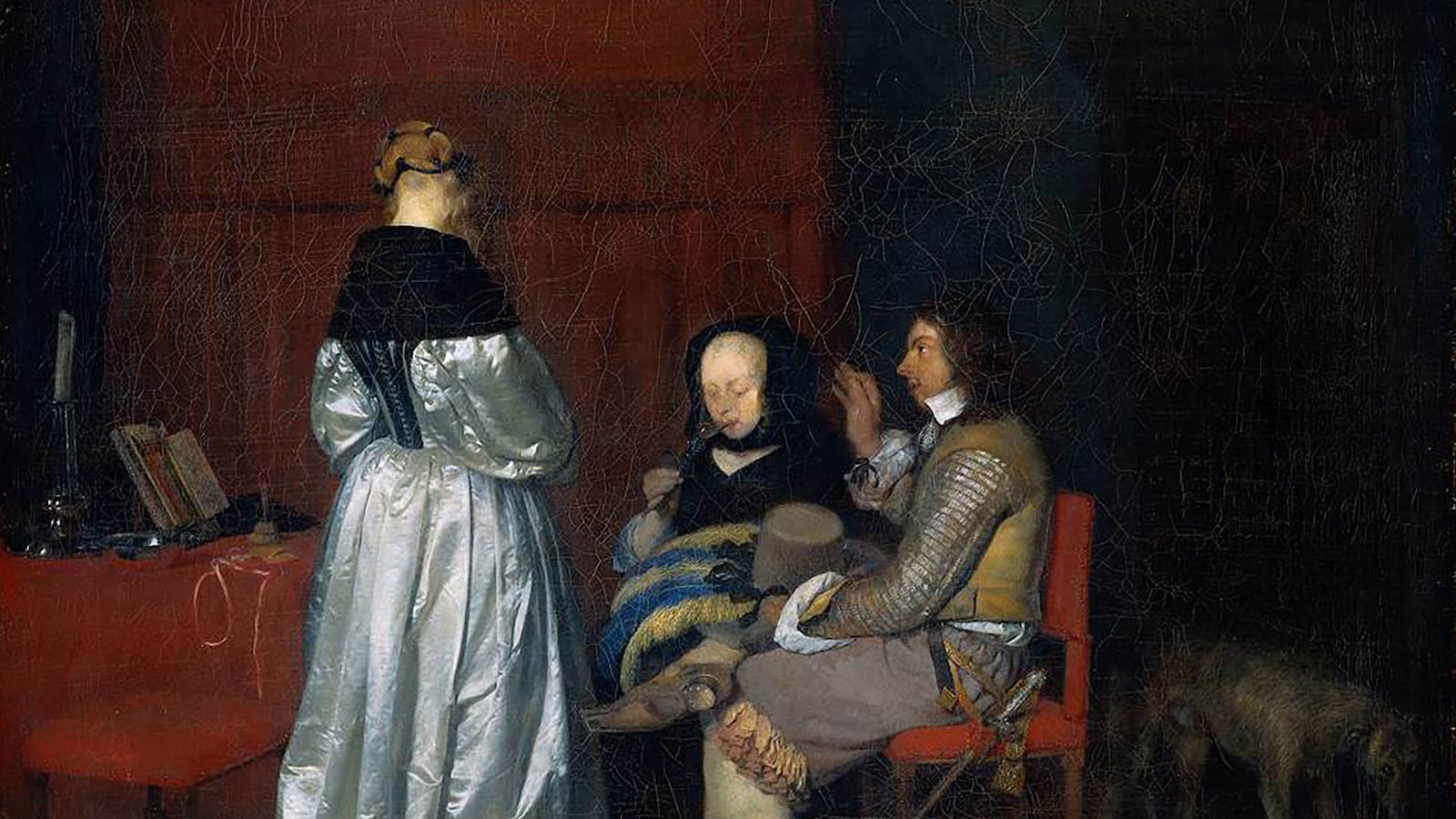I sometimes think that every museum label should carry a disclaimer: “Warning. The title you are about to read may tell you more about the historical reception of the painting than it does about the painting itself.”
Google “Rembrandt” and “philosopher,” for instance, and the first thing you will see on your screen is the image of a painting that now hangs in the Louvre. The painting, which is titled Philosophe en méditation (philosopher in meditation) and dated 1632, shows an old bearded man seated in an interior, with a large open book on the table beside him. Golden light from a window illuminates his figure, while the rest of the interior is plunged in shadows. To his right is a winding stair that disappears into a dark recess and the bent form of an old woman tending a fire. Though you won’t be able to see it on the screen, the indistinct form of another woman is also disappearing up the stair.
Ever since this painting arrived at the Louvre at the end of the eighteenth century, commentators have been tempted to associate its “philosophe” with the contemplative artist who created him. One nineteenth-century French poet simply decided that Rembrandt was the philosopher. Another saw “the very genius of Rembrandt” in the figure and attributed the picture as a whole to the artist’s wish for “an interior in which to house his mysterious thought.” In the mid-twentieth century, the writer and philosopher Aldous Huxley described the painting’s “symbolical subject matter” as “nothing more nor less than the human mind” itself.
Rembrandt, however, had nothing to do with naming his picture. Like many paintings from the Dutch Golden Age, this one owes its title to a reproductive printmaker, who engraved the image for popular consumption more than a century after the artist painted it. This particular printmaker may in turn have taken his cue from a French owner of the painting, who was already calling it and a companion piece (then also attributed to Rembrandt) his “deux philosophes” several years before both pictures were engraved in 1753-54. Once the print began to circulate, the title stuck to the painting too. But the philosopher these men thought they saw in Rembrandt’s picture is almost certainly their invention—a product of their own Enlightenment era, when “philosophes” flourished, rather than the creation of the artist.
Among other reasons for doubting the title, I am sorry to report, is that woman bending over the fire: there is apparently no iconographical tradition of philosophers accompanied by women! Though her presence has prompted one knowledgeable commentator to associate the picture with the relatively obscure biblical story of Tobit and his wife Anna, the exact subject of Rembrandt’s painting remains a mystery. Meanwhile, it continues to be known—and therefore generally understood—as his Philosopher in Meditation.
We are probably indebted to the printmakers for the idea that a picture should have a title in the first place. Among the most successful of these reproductive artists was a German engraver based in Paris named Jean Georges Wille (1715-1808), whose magnificent prints circulated throughout Europe in the late eighteenth and nineteenth centuries. Wille earned particular fame for his reproductions of seventeenth-century Dutch genre paintings—those pictures of everyday life that still draw crowds to modern museums—and perhaps his most celebrated image was a print after Gerard ter Borch that he called L’instruction paternelle (1765) or The Paternal Admonition, as it is usually translated in English. (We know that this title was Wille’s rather than the painter’s from a diary kept by the printmaker.) So famous did this particular print become that a half-century later Goethe was still inquiring rhetorically, “Who does not know Wille’s magnificent copper engraving of this painting?”

Ter Borch’s picture shows three figures in an interior: a young woman dressed in white satin and standing with her back to us; a seated man who raises his hand in a gesture that Wille apparently took as a sign of warning or correction; and an older woman, also seated, who faces the viewer as she sips from a wine glass.
The picture was painted around 1654-55; Wille engraved and titled it more than a century later. And so suggestive did that title prove that Goethe could spin an entire small narrative from its cues.
In one of his own most important works, the 1809 novel Elective Affinities, Goethe’s characters act out a tableau vivant based on Wille’s print:
A noble knight sits, with crossed feet, evidently severely lecturing his daughter, who faces him… [S]he can only be seen from the back, but her whole posture seems to indicate that she is controlling herself. The expression and gesture of the father tells us, however, that his reproof is not too violent or humiliating; and the mother seems to hide a slight embarrassment while she gazes into the glass of wine she is about to sip.
This little story had its own afterlife. When the future novelist George Eliot toured the Berlin museum in 1854, she recorded in her journal how “pleased” she was to “recognize among the pictures” the one Goethe had described in his novel: “It is the daughter being reproved by her father, while the mother is emptying her wine glass.” She was looking at the Berlin original, but her memory for its titular narrative was evidently stronger than her recall of the painter himself, since the same journal entry attributes the picture in question to another Dutch artist, Jan Steen.
The trouble, of course, is that we have no way of knowing whether ter Borch had anything like Wille’s instructive scenario in mind. The painting exists in two versions—the one in Berlin and another at the Rijksmuseum in Amsterdam. By the middle of the twentieth century, the scholarly consensus had shifted the scene from a domestic interior to an upscale brothel, as the standing figure morphed into a courtesan, while her erstwhile parents turned, respectively, into a would-be client and his wine-sipping procuress.
This more salacious reading appeared to receive further reinforcement when the cleaning of the Berlin picture revealed to some eyes the traces of a coin in the gentleman’s hand. Rather than a gesture of admonition, the hand was apparently engaged in offering payment for sexual services about to be rendered. So much, it would seem, for Wille’s edifying image of family life in the Dutch Golden Age!
Unhappily for the brothel theory, however, that coin has since been pronounced a phantom.
Recent commentators on the painting generally agree that the original meaning of the scene remains elusive, but museums and catalogs still require a title. When I last checked, the Rijksmuseum had chosen to call its version The Gallant Conversation, followed in parentheses by the phrase, “known as The Paternal Admonition.” At Berlin, the picture continued to go by the name Wille gave it.
By the nineteenth century, most viewers seem to have taken for granted both that paintings had titles and that artists supplied them. Yet then as now, many painters continued to leave the naming of their work to others. We still don’t know whether any of Paul Cézanne’s titles, for example, originated with the artist.
His influential dealer, Ambroise Vollard, tells an amusing story of one early picture, a landscape with some female nudes and “a person who from his getup could be taken for a shepherd.” In the course of arranging for a show, he accidentally placed the canvas in a frame that still bore the legend from a previous picture. Cézanne’s painting was thus inadvertently baptized Diana and Acteon—and interpreted accordingly. One critic even praised “the nobility of the goddess’s attitude and the modest air of the virgins who surrounded her,” as the chaste company indignantly repelled the spying Acteon.
Sometime later, the same dealer was asked to lend a Temptation of Saint Anthony by Cézanne to another exhibit. Unfortunately for the exhibiters, the painting Vollard had promised them had been sold in the interim. But he still had custody of the other picture, which he mischievously sent on instead.
This time there were no words on the frame, but since the exhibiters were expecting a Temptation of Saint Anthony, that’s how it was listed in the catalog. Where one critic had seen the chaste Diana, another now spotted “the smile, at once bewitching and perfidious, of a daughter of Satan”; the indignant gesture of the goddess’s attendant now turned into “a seductive invitation,” while “the pseudo- Acteon” became a “moving Saint Anthony.”
A collector who had previously refused the supposed Diana and Acteon because he already owned a painting of the subject by another artist now triumphantly announced his purchase of the rejected canvas under its new name. “It has a striking realism!” he boasted. Cézanne himself, on the other hand, denied that his painting had any subject at all. “I merely tried to render certain movements,” the artist protested, when he learned of these titular adventures.
Reading by the title, as I call this process of seeing what it tells you to see, is not limited to pictures of the human figure. One of my favorite stories concerns an abstract expressionist painting by Jackson Pollock that now hangs in the Metropolitan Museum of Art in New York. The painting is entitled Pasiphaë (1943) after the mythical queen who cuckolded King Minos with a bull and gave birth to the Minotaur. Taking his cue from the title, a future director of painting and sculpture at MoMA associated the painting’s “energetic motifs” with “sexual abandon,” “physical ecstasy,” and “animal passion.” The poet and art critic Frank O’Hara identified the picture with “the amorous nature of bestiality” and saw in it “the stark, staring and foreboding figure of Pasiphaë… with her foreknowledge of the Minotaur and her lust.”
But what are we to make of such visions once we learn that “Pasiphaë” was not Pollock’s title at all, but the belated suggestion of a curator at MoMA, who offered it as a substitute when the artist’s patron, Peggy Guggenheim, objected to his original choice of “Moby-Dick”? “Who the hell is Pasiphaë?” Pollock is said to have responded, and many viewers may still share his bewilderment. Yet Pollock also accepted the title, and for more than a half-century his canvas has continued to be known as Pasiphaë. At what point, if any, might those of us with a taste for ancient myth be justified in thinking of the lustful queen when we look at his painting?
Ruth Bernard Yeazell is the Chace Family Professor of English and director of the Lewis Walpole Library at Yale University. Her latest book is Picture Titles: How and Why Western Paintings Acquired Their Names.






